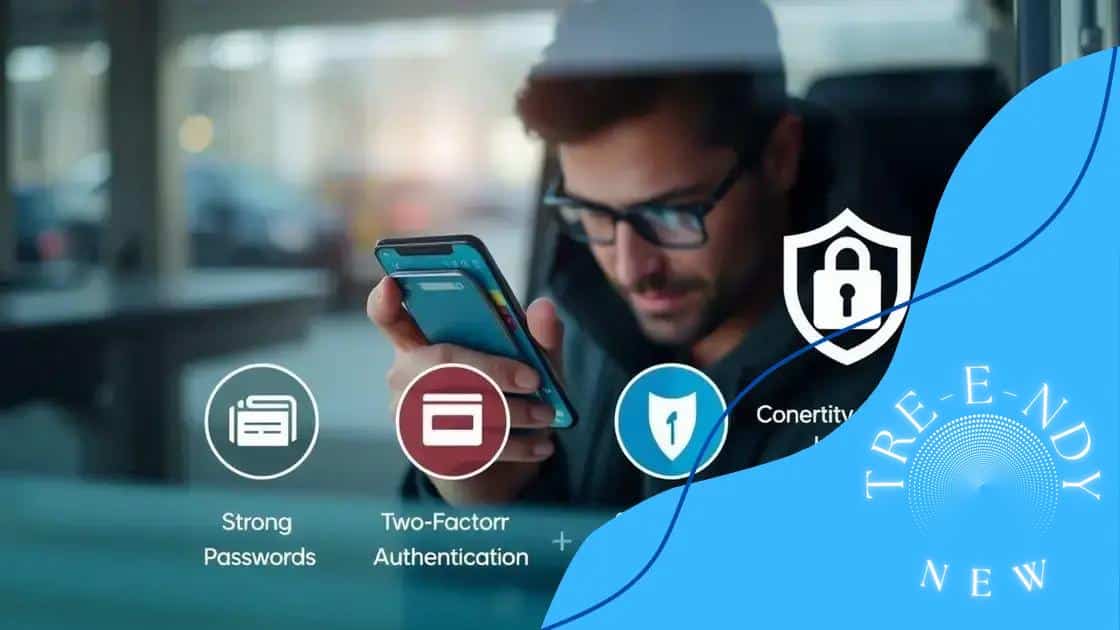Digital wallet security protocols: safeguarding your finances

Digital wallet security protocols include strong passwords, two-factor authentication, and encryption, which are essential to protect sensitive financial information from unauthorized access and cyber threats.
Digital wallet security protocols are more important than ever in our cashless society. Have you ever wondered how secure your transactions really are? Let’s dive into the measures that keep your finances safe.
Understanding digital wallet security
In today’s tech-savvy world, understanding digital wallet security is crucial for protecting your financial information. As we rely more on digital payments, being aware of how these technologies work can help enhance your security.
Digital wallets have transformed the way we handle transactions. But what makes them secure? Let’s look into the protocols that ensure your information stays safe.
Key Security Features of Digital Wallets
Digital wallets incorporate multiple layers of security. Here are some essential features:
- Encryption: This process secures your data, making it unreadable to unauthorized users.
- Two-factor authentication: This adds an extra step in the verification process to ensure it’s you accessing the wallet.
- Tokenization: This replaces sensitive data with unique identification symbols, reducing risks during transactions.
- Security updates: Regular updates to the app enhance protection against newly discovered threats.
These features work together to create a robust security environment. However, the effectiveness depends significantly on how users manage their wallets. For instance, utilizing strong passwords and only accessing wallets over secure connections can greatly reduce risks.
Understanding vulnerabilities is also key. Users must be aware of potential phishing attacks and how to recognize them. Always verify sources or links before entering sensitive information. By staying informed, you’ll be better prepared against cyber threats.
As technology evolves, so do the threats. Continuous education about digital wallet security will help you navigate these challenges effectively. Embracing best practices is vital to maintaining your financial safety.
Key protocols for protecting your data
When it comes to securing your information, understanding the key protocols for protecting your data is essential. These protocols serve as the backbone of digital security, ensuring that your sensitive information remains safe from potential threats.
Numerous protocols help safeguard your data. Employing these can help build a secure environment for your financial transactions. One crucial aspect is encryption. This process converts your data into a coded format, which only authorized users can decode. It’s a fundamental layer that makes data theft extremely difficult.
Important Security Protocols
Several protocols play a key role in data protection:
- SSL/TLS: This secures the connection between your device and the server, ensuring data sent over the internet is safely encrypted.
- PGP: Pretty Good Privacy encrypts emails and files, adding an extra layer of confidentiality.
- VPN: Using a Virtual Private Network creates a secure connection to the internet, effectively hiding your online activity.
- Secure storage: Keeping your information in secure cloud storage ensures only you have access to it.
In addition to these protocols, utilizing strong passwords is vital. Passwords should be complex, containing a mix of letters, numbers, and symbols. Frequent changes to passwords also enhance your security.
Furthermore, being aware of phishing schemes is crucial. Always double-check URLs and avoid sharing sensitive information unless you’re sure of the recipient’s identity. Awareness can significantly reduce the risk of data breaches.
Adopting these protocols not only protects your personal data but also boosts your confidence during online transactions. As you implement these methods, you create a safer digital environment for yourself.
Best practices for users of digital wallets

To maximize the safety of your finances, adhering to the best practices for users of digital wallets is essential. Being proactive can significantly enhance your security and offer peace of mind while transacting online.
First and foremost, always use a strong password. Your password should include a mix of upper and lower case letters, numbers, and special characters. This makes it more difficult for unauthorized individuals to gain access to your account.
Key Best Practices
Here are some important practices to ensure your digital wallet remains secure:
- Enable two-factor authentication: This adds an extra layer of security by requiring a second verification step before accessing your wallet.
- Keep software updated: Regular updates ensure that you have the latest security features and patches against vulnerabilities.
- Monitor your account: Regularly check your transaction history to catch any unauthorized activity early.
- Be cautious of Wi-Fi networks: Avoid using public Wi-Fi for transactions as it can expose your data to hackers.
Additionally, be aware of phishing attempts. Always verify the source of emails or messages before clicking on any links. Cybercriminals often impersonate trusted entities to steal your information.
Furthermore, consider using a digital wallet with built-in security features, like biometric verification (fingerprint or facial recognition). These features provide advanced protection against unauthorized access.
Storing your wallet details securely is another crucial practice. Avoid sharing your passwords or sensitive information over text or social media. Using a secure notes app can be helpful for managing sensitive information safely.
Common vulnerabilities in digital wallets
Understanding the common vulnerabilities in digital wallets is essential for any user looking to safeguard their financial data. These vulnerabilities can lead to unauthorized access or financial loss, making awareness crucial.
One significant vulnerability is poor password management. Many users either choose weak passwords or reuse them across multiple platforms. This practice can open doors for hackers, especially if one account is compromised.
Types of Vulnerabilities
Some frequent vulnerabilities include:
- Unpatched software: Failing to install updates can leave wallets exposed to known security flaws.
- Phishing attacks: Cybercriminals often send fake emails to trick users into providing their personal information.
- Insecure networks: Using public Wi-Fi for transactions can expose your data to hackers.
- Lack of two-factor authentication: Not enabling this feature means relying solely on your password, which can be unsafe.
In addition, users may overlook the importance of secure connections. Accessing a digital wallet over an unsecured connection can jeopardize personal data, so ensuring a secure HTTPS connection is vital.
Another common issue is the storage of sensitive information. Some users may store their wallet information in unsecured apps or documents, making it easy for cybercriminals to access it.
Users must remain vigilant and proactive against these vulnerabilities. Awareness and education about these risks can help in avoiding pitfalls, leading to a safer digital wallet experience. Regularly reviewing security practices can ensure users are not caught off guard.
Future trends in digital wallet security
As technology continues to evolve, it is crucial to stay informed about the future trends in digital wallet security. These trends will shape how users protect their financial information in the coming years.
One significant trend is the advancement of biometric authentication. More wallets are integrating features such as fingerprints and facial recognition, providing users with a quick and secure way to access their accounts. This method greatly reduces the chances of unauthorized access.
Emerging Security Technologies
Several technologies are gaining traction in the realm of digital wallet security:
- Artificial intelligence: AI can analyze patterns and detect unusual activities, enhancing fraud detection.
- Blockchain technology: This offers increased security through decentralized transactions, making it harder for hackers to manipulate data.
- Enhanced encryption methods: More sophisticated algorithms are being developed to protect sensitive information.
- Secure hardware elements: New devices are incorporating dedicated security chips to protect wallets against theft and hacking.
Another key trend is the rise of privacy-focused regulations. Governments are increasingly recognizing the importance of data protection and are implementing stricter laws. This shift will necessitate that wallet providers strengthen their security measures to comply with regulations.
Moreover, the increasing integration of digital wallets in various sectors, such as e-commerce and banking, demands robust security. Users should expect enhanced verification processes and more user-friendly security features.
As digital wallets become more widely adopted, the push towards greater security will be a priority for both providers and users. Staying aware of these trends will help individuals make informed choices about their digital wallet usage.
In conclusion, understanding digital wallet security is vital for anyone who uses this technology. By learning about best practices and staying informed about common vulnerabilities, users can better protect their financial information. As we look to the future, embracing new security technologies will play a crucial role in keeping our digital transactions safe. Staying updated on these trends allows users to navigate the digital wallet landscape confidently.
\n\n
\n
FAQ – Frequently Asked Questions about Digital Wallet Security
What are digital wallets?
Digital wallets are applications that allow you to store your payment information and make transactions using your smartphone or computer.
How can I secure my digital wallet?
You can secure your digital wallet by using strong passwords, enabling two-factor authentication, and avoiding public Wi-Fi for transactions.
What should I do if I suspect unauthorized access to my wallet?
Immediately change your password, review your transaction history, and contact your wallet provider’s customer support for assistance.
Are digital wallets safe to use?
Yes, digital wallets can be safe to use if you follow best practices for security, such as enabling encryption and regularly monitoring your account.





